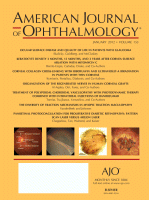Le maculopatie essudative non sono tutte uguali e non rispondono tutte nella stessa maniera alla terapia con inibitori del VEGF. In particolare la sottocategoria definita “vasculopatia polipoidale” (PCV) rientra tra quelle che danno una risposta poco soddisfacente. Questa forma di maculopatia essudativa richiede l’esame con indocianina (ICG) per essere individuata.
In questo studio retrospettivo gli studiosi giapponesi hanno valutato l’efficacia della terapia combinata con inibitore del VEGF e della terapia fotodinamica (PDT) su 66 occhi.
I risultati mostrano che, dopo un anno dall’insorgenza della malattia, la terapia combinata porta ad un importante miglioramento visivo e ad una scomparsa della lesione polipoidale nel 79% dei casi, anche se si sono registrati, tra gli effetti avversi diversi casi di complicazioni emorragiche.
Kaoruko Tomita, Akitaka Tsujikawa, Kenji Yamashiro, Sotaro Ooto, Hiroshi Tamura, Atsushi Otani, Yoshihito Nakayama, Nagahisa Yoshimura
American Journal of Ophthalmology
January 2012, Volume 153, Issue 1, Pages 68–80.e1
Purpose To evaluate the 1-year efficacy and safety of photodynamic therapy (PDT) combined with intravitreal injections of ranibizumab for polypoidal choroidal vasculopathy (PCV).
Design Retrospective chart review.
Methods We retrospectively reviewed the medical records of 63 consecutive patients (66 eyes) with subfoveal PCV who were treated with PDT combined with intravitreal injections of ranibizumab. Of the 66 eyes, 29 had no history of treatment for PCV, 10 had been treated previously with only intravitreal injections of anti–vascular endothelial growth factor agents, and 27 had been treated previously with PDT. All eyes had a minimal follow-up of 12 months.
Results The combined therapy reduced substantially the exudative change immediately after initiation of treatment. In treatment-naïve eyes, mean VA before treatment (0.47 ± 0.37 logarithm of the minimal angle of resolution [logMAR]) improved to 0.32 ± 0.30 (P < .01) at 3 months and to 0.29 ± 0.29 (P < .01) at 12 months. Polypoidal lesions were reduced in all eyes and disappeared completely in 79.1% of cases. In eyes treated previously with only anti–vascular endothelial growth factor therapy, some visual improvement was achieved, but in eyes treated previously with PDT, mean visual acuity (0.61 ± 0.45) deteriorated to 0.68 ± 0.52 at 12 months. Of all 66 eyes, 5 showed extensive postoperative subretinal hemorrhage, in 2 of which a vitreous hemorrhage developed, necessitating pars plana vitrectomy.
Conclusions PDT combined with ranibizumab led to significant visual recovery in treatment-naïve eyes with PCV, but not in eyes with PCV that had demonstrated recurrence after previous PDT. PDT in combination with ranibizumab still has a risk of the postoperative hemorrhagic complications.

 Treatment of Polypoidal Choroidal Vasculopathy with Photodynamic Therapy Combined with Intravitreal Injections of Ranibizumab
Treatment of Polypoidal Choroidal Vasculopathy with Photodynamic Therapy Combined with Intravitreal Injections of Ranibizumab